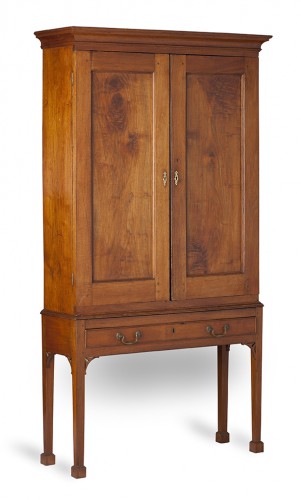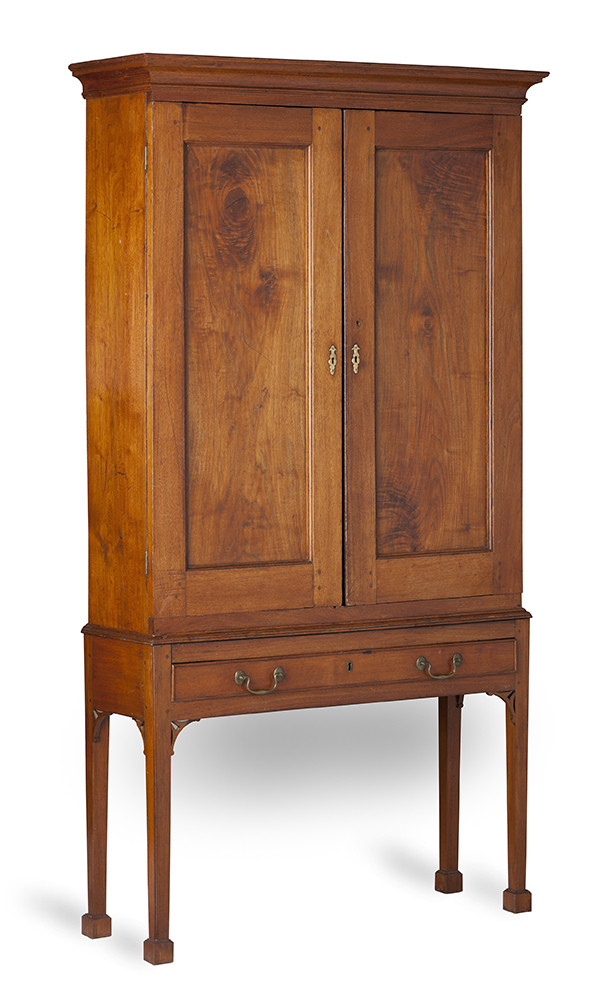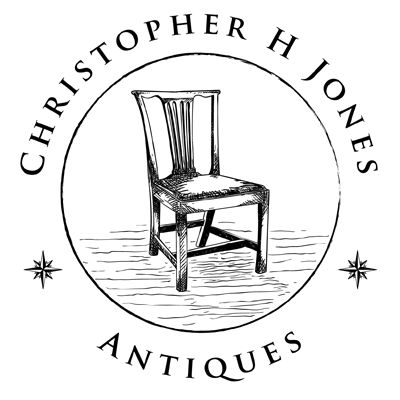 An exceptional Virginia, Black Walnut Book Press on stand
An exceptional Virginia, Black Walnut Book Press on stand
Tidewater Virginia, Possibly Williamsburg
Circa 1785-95
Dimensions: 71 ¾” tall, 13” deep, 39 ¼” wide.
Commentary: This book press represents an elegant example of a furniture form now quite rare but which was not uncommon in the homes of Virginia gentry during the eighteenth century. Given the frequency that book presses are found on period inventories, it is somewhat surprising how few are known today. The Room Use Study conducted by Gunston Hall notes that even with storage available in desk bookcase combinations or cupboards, there was some demand for separate bookcases or “presses” as they were often termed during the period. The Gunston study concludes that some variation of the book press form was owned by approximately twenty five per cent of the elite homes studied. Numerous examples can be cited from some of the region’s most prominent homes.
Peyton Randolph’s Williamsburg study was graced by “6 Mahogany Book presses” which held his large and valuable library. The account of the sale of the estate of John Parke Custis in 1761 notes “1 Book Case & Draws” sold to Patr. Connelly for 3 pounds 13. Robert Carter of Nomini Hall owned several presses and the sale advertisements for William Byrd’s library advised that his books were “contained in twenty three double Presses of black Walnut.” Col. James Madison owned a pine bookcase made by Robert Cockburn which the cabinet maker recorded in his accounts along with several other items of furniture he supplied, presumably for Montpelier. Cockburn’s accounts also list a cabinet of chiritree made for Captain Laurence Taliferro for 13 pounds, a substantial sum equivalent to the cost of approximately 2 dozen chairs. George Mason referred in correspondence to a “book Case in the Dining-Room” of his home Gunston Hall. Williamsburg jurist Saint George Tucker owned at least 14 book presses acquired from local artisans.
Southern Furniture, however, records only a single example of a book press on stand (fig. 123.8) that was attributed to Williamsburg cabinetmaker Rookesby Roberts, circa 1785 and belonged to St. George Tucker. (A related but earlier cabinet fitted with drawers in the collection of Colonial Williamsburg, Cat 126 Southern Furniture, shares a number of similarities as well as the same design sources. ) The Roberts example is considerably less sophisticated in proportions and detail, lacking the drawer in the base, corner brackets and blocked “Marlborough” feet. (67 5/8”x 44 7/8 x 14 3/16). In 1805 Tucker also ordered “One walnut Book press” from Williamsburg cabinetmaker John Hockaday – valued at 9 pounds, along with a mahogany cabinet valued at 3 pounds 6, a mahogany wardrobe and chest of drawers, valued together at 25 pounds.
The design for this book press on stand is derived from Chippendale’s Director, Plate CXX and also combines elements of the author’s recommendations for writing tables. These designs were themselves, drawn from the elegant cabinets on stand, often decorated with rich veneers or marquetry, fashionable in Europe in the first decades of the eighteenth century. The cabinet or press on stand seems to have been considerably more popular in England and on the Continent than in North America. This form with glass doors used to display china was found frequently in English gentry homes although their use for book storage was less common.
Spandrel brackets, quite often simple in design, frequently embellished tables, chair and, in particular, cellarets made in the Virginia tidewater. Stylistically, these brackets are associated with designs provided by Chippendale but they vary considerably in their interpretation by cabinetmakers. Southern examples are, in general, less ornate with simpler lines than those found elsewhere. It is interesting to note that the style of brackets and the heavier cock beading on the drawer appear in furniture produced by the Sharrocks and related shops in the Roanoke River basin; a group of cabinetmakers strongly influenced by Norfolk and Williamsburg.
Construction: The unusual construction of the “Marlborough” or block foot may eventually lead to the identity of the maker of this press. The very skillfully mitered blocks are applied to the four sides of the slightly tapered legs of the base. The size of the square (cross section) reduces rapidly within the blocking suggesting that an internal shoulder has been cut to provide strength and stability. The technique also allowed the cabinetmaker to affix the feet to a constant (untappered) section which facilitated the perfect miters.
The primary wood is American Black Walnut (Juglans nigra) and the secondary wood is Eastern White Pine (Pinus strobus) both commonly in use in tidewater Virginian shops during the period. Well before the Revolutionary War, large quantities of white pine were arriving in southern ports from New England and were marketed to joiners and cabinetmakers. By way of example, advertisements in 1767 & 1768 in Williamsburg’s Virginia Gazette, noted shipments of 8800’, 3000’ and 3000’ of pine boards from Boston.
This book press was carefully inspected in 2010 by Wallace Gusler, former curator of furniture at Colonial Williamsburg. In a written report on the press, Gusler attributed the piece to “Eastern Virginia, possibly Williamsburg, Richmond” based on style, form and materials. He dated its construction to the 1790’s based primarily on the presence of cut shank nails along with the earlier hand forged variety.
Samples were taken from the upper and lower sections, both front and rear, and subjected to Fourier Transform-Infrared Spectroscopy (FTIR) by Richard Wolbers in the Winterthur Conservation Laboratory. Analysis of these samples verified that the surface histories of the upper and lower portions are identical and that they match standard “fused” or aged varnish samples from the Winterthur data base.
Condition: The two missing diagonal structural braces whose positions were clearly indicated by notches in the lower section were replaced in 2011 by Schuettinger Conservation Services. At the same time the missing lock in the upper case was replaced, minor repairs made to two of the original brackets and the one previously replaced bracket was replaced. A previously repaired area near the upper proper left hinge was re-glued. The walnut surfaces were treated with a light coating of paste wax. A full conservation report is available in the object file.
Price: SOLD


